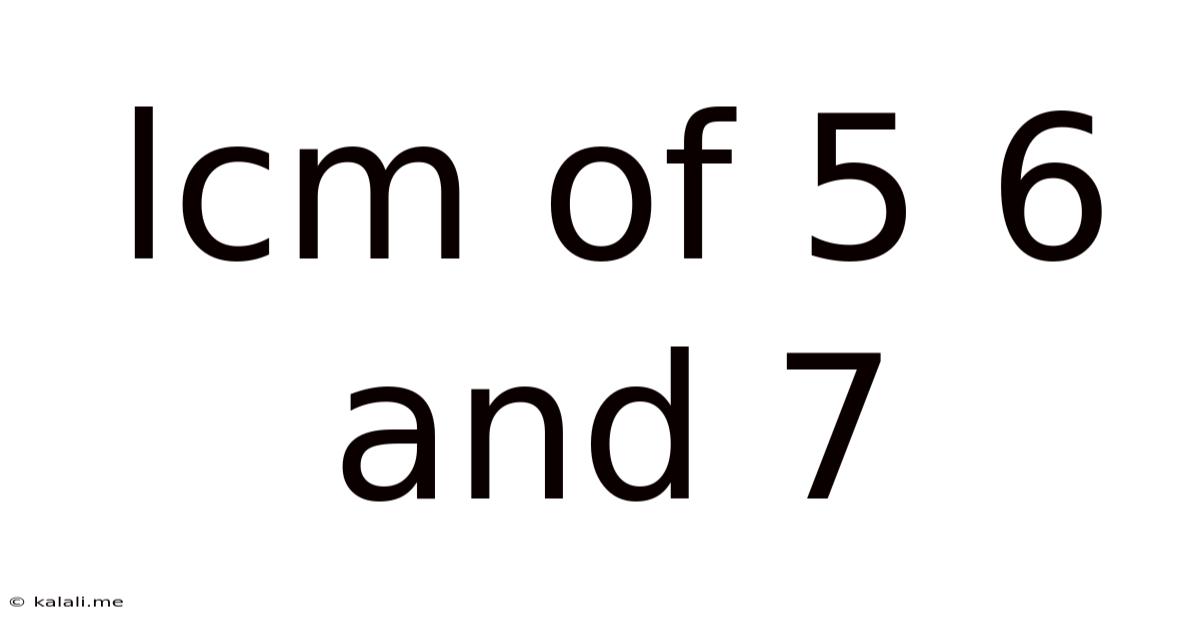Lcm Of 5 6 And 7
Kalali
Jun 11, 2025 · 3 min read

Table of Contents
Finding the LCM of 5, 6, and 7: A Step-by-Step Guide
Finding the least common multiple (LCM) of a set of numbers is a fundamental concept in mathematics, with applications ranging from simple fraction addition to more complex scheduling problems. This article will guide you through calculating the LCM of 5, 6, and 7, explaining the process in a clear and concise manner, perfect for students and anyone needing a refresher. Understanding how to find the LCM is crucial for various mathematical operations and problem-solving.
What is the Least Common Multiple (LCM)?
The least common multiple (LCM) is the smallest positive integer that is a multiple of two or more numbers. In simpler terms, it's the smallest number that all the numbers in your set can divide into evenly. For example, the LCM of 2 and 3 is 6, because 6 is the smallest number that is divisible by both 2 and 3.
Methods for Finding the LCM of 5, 6, and 7
There are several ways to calculate the LCM, but we'll focus on two common and efficient methods: prime factorization and the listing method.
Method 1: Prime Factorization
This method is generally preferred for larger numbers or sets of numbers. It involves breaking down each number into its prime factors – numbers divisible only by 1 and themselves.
-
Find the prime factorization of each number:
- 5 = 5 (5 is a prime number)
- 6 = 2 x 3
- 7 = 7 (7 is a prime number)
-
Identify the highest power of each prime factor:
- The prime factors present are 2, 3, 5, and 7.
- The highest power of 2 is 2¹ = 2
- The highest power of 3 is 3¹ = 3
- The highest power of 5 is 5¹ = 5
- The highest power of 7 is 7¹ = 7
-
Multiply the highest powers together:
- LCM(5, 6, 7) = 2 x 3 x 5 x 7 = 210
Therefore, the least common multiple of 5, 6, and 7 is 210.
Method 2: Listing Multiples (Suitable for smaller numbers)
This method involves listing the multiples of each number until you find the smallest common multiple.
-
List the multiples of each number:
- Multiples of 5: 5, 10, 15, 20, 25, 30, 35, 40, 45, 50, 55, 60, 65, 70, 75, 80, 85, 90, 95, 100, 105, 110, 115, 120, 125, 130, 135, 140, 145, 150, 155, 160, 165, 170, 175, 180, 185, 190, 195, 200, 205, 210,...
- Multiples of 6: 6, 12, 18, 24, 30, 36, 42, 48, 54, 60, 66, 72, 78, 84, 90, 96, 102, 108, 114, 120, 126, 132, 138, 144, 150, 156, 162, 168, 174, 180, 186, 192, 198, 204, 210,...
- Multiples of 7: 7, 14, 21, 28, 35, 42, 49, 56, 63, 70, 77, 84, 91, 98, 105, 112, 119, 126, 133, 140, 147, 154, 161, 168, 175, 182, 189, 196, 203, 210,...
-
Find the smallest common multiple: The smallest number appearing in all three lists is 210.
Therefore, using the listing method, we again confirm that the LCM of 5, 6, and 7 is 210.
Conclusion
The LCM of 5, 6, and 7 is 210. Both the prime factorization method and the listing method provide accurate results, but the prime factorization method is generally more efficient for larger numbers. Understanding how to find the LCM is essential for various mathematical applications and problem-solving scenarios. Remember to choose the method that best suits your needs and the complexity of the numbers involved.
Latest Posts
Latest Posts
-
How Do You Say Grandparents In Spanish
Jul 02, 2025
-
How Many Numbers Are Between 48 To 24
Jul 02, 2025
-
How Many Positions Are There In Sex
Jul 02, 2025
-
How Many Minutes Are In 10 Miles
Jul 02, 2025
-
How Many Milliseconds Are In A Day
Jul 02, 2025
Related Post
Thank you for visiting our website which covers about Lcm Of 5 6 And 7 . We hope the information provided has been useful to you. Feel free to contact us if you have any questions or need further assistance. See you next time and don't miss to bookmark.